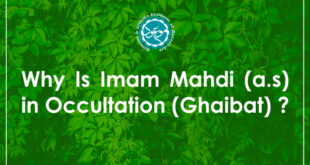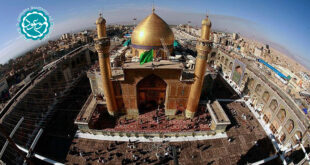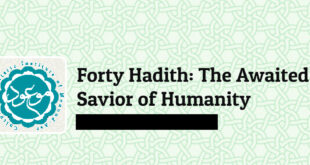This encyclopedia consists of fourteen sections and seventy chapters. It caters to the subject of Mahdaviyyat and its different perspectives, based on the verses of Quran and authentic traditions.
This encyclopedia on Madaviyyat, which is a product of research center belonging to the Institute of Dar al-Hadith, a scholastic cultural institute, has been presented to the supreme leader of Revolution on the auspicious occasion of 15th Shabaan.
For the sake of familiarity with this work, let’s have a quick look at different sections and chapters of this encyclopedia.
Section 1: Mahdaviyyat, a general outlook
Due to importance of the topic of Mahdaviyyat and its special beliefs, before going into the details of life of Imam Mahdi (a.s) from birth till formation of a global government, this section takes a general look at it from the perspective of Quran, Prophet (sws) and Ahl-e-Bait (a.s).
1-1: Continuation of Divine leadership (Imamat)
This section mentions the verses and traditions which depict the necessity of presence of Imam and proof of God on earth at all times, from the beginning of human society till the end of world. Also these traditions prove that, after the demise of Prophet (sws), the Imams will be from his (sws) progeny. At the end of this chapter, these traditions are analyzed and some doubts answered.
1-2: Continuation of Imamat in the Prophet (sws)’s progeny
In this chapter, a very important issue of continuation of Imamat in the progeny of the last Prophet (sws) is proved, based on the mutawatir tradition of Thaqalain related by both, Shias and Sunnis. At the end of this chapter, there is a summarized analysis of the authenticity of this tradition, its indication towards infallibility of Ahl-e-Bait (a.s), their authority in knowledge as well as Imamat of Imam Mahdi (a.s) and his (a.s) absence. In addition, it also describes few significant points regarding this tradition as well.
1-3: Count of divine leaders after the Prophet (sws)
This chapter, first describes a number of traditions from the Prophet (sws), in various expressions, which identify the leaders after him (sws) and in continuation of the chapter, research is done into the references of these tradition, their origin in time and place, differences in their content, their purpose and different opinions that exist in this regard, proving that the opinion accepted by the followers of Ahl-e-Bait is only the right one.
1-4: Obligation of knowing the Imam Mahdi (a.s)
This chapter proves, based on the authentic traditions that, it is obligatory for every Muslim to have a recognition of Imam of his time, who is from the progeny of Prophet (sws). Then it mentions the excellence of knowing the Imam and dangers of not knowing it. It also brings the traditions from Ahl-e-Bait, which prohibit us from denying of Imams, specifically the twelfth Imam (a.s). In the end, it explains the responsibility of those who are not capable of knowing the Imam (a.s).
1-5: Glad tidings of Quran
The subject of this chapter, is the glad tidings in different verses of Quran, regarding the expanse of Islam, formation of Government by the righteous, and leadership of powerless in the future. In the end it investigates into the verses which point towards the global government of Imam Mahdi (a.s).
Section 2: Life of Imam Mahdi (a.s)
In this section, the life of Imam Mahdi (a.s), from his genealogy till his long life based on traditions from Prophet (sws) and Ahl-e-Bait (a.s) has been explained into seven chapters, as mentioned below.
2-1: Ancestors
This chapter mentions some clear traditions depicting Imam Mahdi (a.s)’s direct relation with the family of Prophet (sws). It also mentions the traditions, which state in detail about his forefathers. By taking into account that, most of Sunnis believe that genealogy of Imam, reaches to the Prophet (sws), through Imam Hasan-e-Mujtaba (a.s), with the help of research done, we will prove that, Imam Mahdi (a.s) is the progeny of Imam Hussain (a.s). This chapter ends with the probe into Imam (a.s)’s mother.
2-2: Birth
This chapter mentions the date of birth of Imam Mahdi (a.s), its circumstances and affairs related to this subject. This chapter probes into three different issues viz. time and place of birth, his (a.s) unusual growth and regarding his (a.s) speech after birth.
2-3: Name
This chapter reports, Imam Mahdi (a.s)’s different names and agnomens. Looking at the belief of some Sunnis who say that, the father’s name of Imam Mahdi (a.s) was homonymous to Prophet (sws)’s name, which contradicts the belief of followers of Ahl-e-Bait, we, in the light of a probe, will disprove it. Then we will come across an analysis of a tradition which stops us, from taking Imam Mahdi (a.s)’s name. In the third analysis, the instruction to stand up in respect when the name “Muhammad” or agnomen “Qa’em” is taken, will be discussed and in the end the agnomen “Aba Saleh” will be discussed.
2-4: Appearance
This chapter talks about, fourteen different characteristics related to the body and appearance of Imam Mahdi (a.s), extracted from the traditions in this regard.
2-5: Long life (age)
This chapter initially mentions a tradition about the long life in three different categories and then discusses the proof of actual possibility of long life and existential proof of long life.
2-6: Characteristics
In this chapter some of the prominent characteristics of Imam Mahdi (a.s) have been collected based on the traditions. Some of them are for example, resemblance with some of the prophets, the Zulqarnain and much of the resemblance with the last Prophet (sws), his (a.s) excellency over other Imams except Imam Ali (a.s), his (a.s) presence in Hajj every year and his (a.s) leadership over inhabitants of heaven. It ends with the explanation regarding the leaders of heaven.
2-7: Some questions answered
In regards to Imam Mahdi (a.s), especially in current times, questions have been raised, knowing the answers of which is necessary, especially for the young generation. In the context of different discussions in this encyclopedia, related questions have been answered. Hence in this chapter, only those issues are handled, which are not discussed anywhere else in the encyclopedia; like Imamat in the childhood, Imam Mahdi (a.s)’s marriage, places related to his (a.s) and Khizra Island etc.
Section 3: Going into absence (Ghaibat) of Imam Mahdi (a.s)
In this section, the issues related to the disappearance of Imam Mahdi (a.s), have been discussed and analyzed across three chapters as mentioned below.
3-1: Prophecy regarding absence (Ghaibat)
Prophecies by Prophet (sws) and Ahl-e-Bait (a.s), about his absence is one of the key steps towards, making the grounds for his absence. So in the beginning of this chapter, a complete analysis have been done regarding the most important steps taken by Ahl-e-Bait for preparing this ground. Then these prophecies are mentioned; like the incidents which divide this absence into two parts, one is small absence (Ghaibat e Sugra) and the other is long absence (Ghaibat e Kubra). At the end, it probes into the modality of Ghaibat and the matter of Sardaab (cellar), known as cellar of disappearance and answers the doubts regarding it.
3-2: Wisdom behind Ghaibat
In this chapter, the secrets behind the Ghaibat, as related by the Ahl-e-Bait (a.s), is explained across seven different titles and at the end it analyses the wisdom behind the absence of Imam Mahdi (a.s).
3-3: Blessings of Ghaibat
This chapter mentions the effects and genesitic blessings of Ghaibat of Imam Mahdi (a.s), in the light of traditions. The blessings, like survival of the universal order and esoteric (spiritual) guidance of humans. And in the end, a probe which continues to explain these traditions.
Section 4: Envoys and deputies of Imam Mahdi (a.s)
This section covers subjects under four chapters in regards to, deputyship structure in the time of Imams till Imam Mahdi (a.s), the situation of Islamic society ending up to the long Ghaibat, special deputies of Imam in the short Ghaibat and false claimants of deputyship and Mahdaviyyat.
4-1: Deputyship organization
This chapter discusses, the reasons behind establishing this organization by Imams (a.s), its responsibilities, structure, its geographical expanse and names of the deputies which reached us.
4-2: Situation of Islamic Society
This talks about the situation of Islamic society before long Ghaibat, into two sub sections. First, it points to the Islamic world during the reign of Abbasids, during the dictatorship of “Al-wathiq billah” till “Al Mu’tamid al-Allah” and then the disintegration of Abbasid empire and Imam’s relationship with statesmen of Bani Abbas.
4-3: Special deputies
This chapters is dedicated to the general biography of four deputies of Imam Mahdi (a.s), during the short Ghaibat viz. Uthman bin Sa’eed, Mohammed ibn Uthman, Husain ibn Ruh, Ali ibn Mohmmed Saimuri.
4-4: False claimants
Fourth chapter deals with important issues, like misuse of fundamental beliefs, motivation of false claimants, grounds which created acceptability, origin of these fake claimants. After this, the history of false Mahdi’s is mentioned. In continuation, the issue of “false claimants of deputyship” is also covered, because of its similarity with “false Mahdi’s”, by mentioning few false claimants of deputyship in the time of short Ghaibat and few in the present time.
Section 5: Letters signed by Imam Mahdi (a.s) (Tauqee’)
This section starts with analyzing the letters from Imam Mahdi (a.s) in his short Ghaibat, by quoting the answers of the questions asked to him (a.s), across four chapters. In the fourth chapter, letter addressing to Shaikh Mufeed (r.a) will be analysed with a critical review.
5-1: Letters regarding beliefs and politics
Some of the letters from Imam mentioned in this chapter, are related to the beliefs like, attributes of God and some of the letters are related to the political issues; like the letter pertaining to the protection of representatives of Imam (a.s) from the enemies. Some contain both the dimensions, beliefs and politics; like the letter related to Imamat and earth, never being void of proof (Imam). At the end, it mentions the letter to the fourth deputy, regarding the end of short Ghaibat and resumption of long Ghaibat.
5-2: Letters regarding jurisprudence (Fiqh)
This chapter deals with the traditions from Imam Mahdi (a.s), where Imam (a.s) has answered many of jurisprudential questions. In continuation it also contains, a comprehensive and expansive analysis regarding the benefits of these traditions.
5-3: Letters indicating Karamaat (Extraordinary acts)
This chapter contains, the letters which point towards the acceptance of Prayer by Imam Mahdi (a.s), or prophecies about some events, that Imam (a.s) has mentioned.
5-4: Other letters from Imam
Letters which are related to subjects, other than the above chapters, are mentioned in this chapter.
Section 6: Meeting with Imam Mahdi (a.s)
This section brings about, the stories of those who met with Imam Mahdi (a.s), before Ghaibat and during his short Ghaibat or long one or those who witnessed extraordinary thing (Karamat) from Imam (a.s).
6-1: Meeting with Imam (a.s) before Ghaibat
This chapter brings about, sixteen accounts of those who have met with Imam Mahdi (a.s), before Ghaibat.
6-2: Meeting with Imam (a.s) during short Ghaibat
This chapter brings about, 26 accounts of those who were able to meet with Imam Mahdi (a.s), during short Ghaibat.
6-3: Meeting with Imam (a.s) during long Ghaibat
This chapter analyzes the possibility of meeting Imam (a.s), during long Ghaibat and further it mentions about 62 such meetings.
6-4: Imam (a.s)’s special attention towards some scholars and jurisprudents
This chapter is related to those scholars who were subjected to the special attention by Imam Mahdi (a.s).
6-5: Memories written by the author
In this chapter, the author brought sixteen memories of meeting Imam (a.s) by the Shias and Imam (a.s)’s extraordinary acts (Karamat).
Section 7: Responsibilities of Muslims during Ghaibat
This section explains the responsibilities of Muslims, especially the followers of Ahl-e-Bait (a.s), across five chapters. These responsibilities are waiting, not being hasty and extreme, persistence, praying and struggle towards forming a global government of Imam Mahdi (a.s).
7-1: Waiting
The first chapter, depicts the importance and emphasis given by the Prophet (sws) and Ahl-e-Bait (a.s) and the privileges of those waiting for the re-appearance of Imam (a.s). In the end their analysis has been given for the interested ones.
7-2: Patience
Taking into consideration, the long period of Ghaibat, it has been stressed upon, by the traditions that, those who are waiting must exercise patience and should do act hastily until the grounds are prepared, for the establishment of global government of Imam Mahdi (a.s). These traditions are presented into four titles.
7-3: Persistence
During the period of Ghaibat, sticking to the wilayat and religion is a difficult task. Hence, many traditions emphasize on persistence in religiosity in this period. These traditions are divided into six sections in this chapter.
7-4: Praying for the Faraj (Expansion of affairs)
A number of traditions from the Prophet (sws) and Imams (a.s), which strongly recommend Muslims to pray for Faraj (expansion of affairs). There are traditions from them as well, which explain the traditions about praying for Faraj. In addition, one of the responsibilities of the followers of Ahl-e-Bait (a.s) during Ghaibat, is to pray for early appearance of Imam (a.s) and expansion of Imam’s affairs. This responsibility is discussed in this chapter in the context of these traditions. Most of these traditions regarding the praying for Faraj, point towards the importance of this particular responsibility.
7-5: Preparing the grounds
The fifth chapter, starts with stating the tradition regarding those who will prepare the grounds for re-appearance of Imam Mahdi (a.s) and ends with a detailed analysis of the most important duty of Shias in the Ghaibat, i.e. making the grounds for uprising by Imam Mahdi (a.s); but due to misuse of these traditions in the history by the power thirsty, some of these traditions will be discussed along with, the people who will rise before the appearance of Imam Mahdi (a.s) with the flag of evil.
Section 8: Prayers (Duas), Intercession and Istekhara
This section consists of the prayers related from Ahl-e-Bait (a.s), about Imam (a.s), or the prayers which are narrated by Imam (a.s) himself. Also, the Istekharas which are related to him (a.s) are reported and in the end, method of interceding Imam (a.s) has been stated. It contains 10 chapters.
8-1: Prayers from Father and other ancestors of Imam (a.s)
This chapter has the prayers from Imam (a.s)’s father and six ancestors about Faraj. It also mentions the effects and privileges of these prayers.
8-2: Prayers from Imam (a.s)
This chapter contains prayers recited by Imam (a.s), during different situations; like during his birth, during Qunoot, near Ka’ba for early realization of Faraj etc.
8-3: Praying for Imam (a.s) during Eids
This chapter deals with the prayers that are recommended at the time of four Eids – Fitr, Adh’ha, Ghadeer and Friday. It also contains the analysis of the reference and content of Dua-e-Nudba.
8-4: Prayers for Imam (a.s) in the month of Ramadhan
This chapter constitutes prayers, which are recommended for everyday of month of Ramadhan, for the day of 13th, 21st and the night of 23rd of this month.
8-5: Prayer on Friday
Subject of this chapter is, the duas to be recited on Friday, after the prayer of Jafer-e-Tayyar, in the afternoon, in the second sermon of Friday prayer, in the Qunoot of Friday prayer, in the evening and at the time of sunset.
8-6: Prayers for Imam (a.s) at other times
This chapter narrates thirteen duas, which are recommended at other days and times.
8-7: Prayers for Imam (a.s) at all times
Three prayers, which are recommended for all times, by Imams (a.s) are stated here. In the end we have analyzed the objective of dua for Imam (a.s), meanwhile answering the questions in this regard.
8-8: Effective prayers from Imam (a.s)
This chapter contains 12 duas for different needs, from Imam Mahdi (a.s).
8-9: Istekhara
The sources which relate the Istekharaas from Imam (a.s), are not authentic; but as these are a type of prayer, reciting them as Raja’ (hope of thawab), has no problem. At the end of this chapter, an investigation into the Istekharaas which are attributed to him (a.s) also exists.
8-10: Intercession
The subject of intercession, for fulfillment of the prayers has been discussed in this chapter. After this, it presents the analysis on the topic of writing letter (Ariza), to Imam (a.s) for intercession.
Section 9: Ziaraat
This section divides the Ziarat into two chapters, first deals with the Ziarat for Imam Mahdi (a.s) and second deals with the Ziarat which are attributed and quoted from him (a.s).
9-1: Ziarat texts for the Imam Mahdi (a.s)
This chapter states, six such texts out of while only one is attributed to Ahl-e-Bait (a.s). The reference of which is assessed in this chapter.
9-2: Ziarat texts attributed to Imam (a.s)
It contains three Ziarat texts, attributed to Imam (a.s). One is the Ziarat of Imam Ali (a.s) which does not have authentic reference. Other two are the Ziarat of the leader of the martyrs Imam Hussain (a.s) on the day of Ashura. Reference of these two are also assessed at the end of this chapter.
Section 10: Signs of re-appearance
10-1: Definite signs
The traditions narrated in this chapter, relate to the signs which are imminent. Meaning, these signs will definitely be realized before Imam (a.s)’s re-appearance; like emergence of Sufyani, Nafs-e-Zakiyya getting killed, hearing of voice from the skies. This chapter ends with a tradition which indicates the possibility of Bada’ in these signs even though they are attributed as definite.
10-2: Non definite signs
The traditions in this chapter quote the signs which are not imminent. At the end, it gives a detailed analysis of the signs of re-appearance irrespective of definite and non-definite.
10-3: Raj’at (The return)
The return of some of the personalities passed away into this world during the last times, is one of the noetic teachings of Ahl-e-Bait (a.s)’s school of thought and fundamental belief. This astonishing event will also take place, at the time of re-appearance of Imam Mahdi (a.s). Hence this chapter deals with this topic and at the end, a detailed analysis, in the context of which, the proofs from Quran and tradition has been given and the doubts related to this are answered as well.
Section 11: Uprising (The revolution)
This section, across nine chapters, talks regarding time and place of the uprising, his (a.s) state and attributes during the uprising, his companions, dissension of Christ (a.s) for his (a.s) aid, flag of Imam Mahdi (a.s), his speech at the beginning of uprising and the way he would encounter with the enemies. At the end of this chapter, we will answer the questions, regarding the period of his (a.s) governance and manner of his(a.s) demise.
11-1: Time of uprising
In this chapter, traditions regarding the time of Imam (a.s)’s uprising under ten different sections, are collected, with three different analysis besides it. One tradition regarding, fixing the time of re-appearance and other regarding the uprising taking place in the last times. At the end, an analysis is presented regarding, whether the “Bada’” also concerns the issue of uprising or not.
11-2: Place of uprising
This chapter deals with the tradition related to the place of Mahdavi uprising with its explanation.
11-3: Appearance of Imam (a.s) during uprising
Based on traditions, Imam (a.s) at the time of uprising is an old person with the features of a young man. Along with these traditions, other traditions are collected in this chapter which, express Imam (a.s)’s body and the clothes.
11-4: Companions of Imam (a.s)
Based on the traditions mentioned in this chapter, the companions are divided into different categories; first: A number of prophets, second: A number of angels, third: A number of those who will come to life again to help the Imam (a.s), fourth: A number of Muslims, from different countries, fifth: A number of those, who haven’t had any benefit at all, explanation of whom is given at the end.
Going forward in this chapter, the physical and spiritual attributes, numbers of special and general companions, the role of women in helping Imam (a.s) and at the end, name and home of some of the companions have been mentioned with the analysis on the companions of Imam (a.s), is discussed.
11-5: Isa (Christ) (a.s) son of Marry (a.s) alongside the Imam Mahdi (a.s)
This chapter, begins with the traditions about descending of Isa (a.s) from the heavens, and continues with his (a.s) praying behind Imam Mahdi (a.s) and Isa (a.s)’s lifetime after this event with citation from the traditions.
11-6: Flag of Imam (a.s)
Subject of this chapter is the characteristics of the flag of Imam Mahdi (a.s) during his uprising; for example, it is stated that, this flag is same as the flag of the Prophet (a.s). Also, it is written on it that : “Al-Bai’ato Lillah (Allegiance is only for Allah (swt))”, or “Isma’oo wa A’ti’oo (Listen and obey the command)”. Creating an intense fear in the hearts of enemy, never defeating are some of the other characteristics of this flag.
11-7: Imam (a.s)’s speech at the beginning of uprising
The traditions collected in this chapter, are the speeches of Imam Mahdi (a.s) during the uprising.
11-8: Encounter with the enemies
The reports in this chapter, tell us about the strict and decisive behavior of Imam Mahdi (a.s) not only with, arrogant and unjust powers, but with false claimants of Shii’sm and that he (a.s) would root out the sedition and corruption from the world.
In the end of this chapter, the traditions regarding the massacre of people will be scrutinized and reviewed.
11-9: Some questions answered
In the last chapter of this section related to the uprising, questions related to the time frame of his (a.s) governance, and the end of his (a.s) blessed life will be answered.
Section 12: Nature of governance
In this section, traditions regarding the methodology of governance of Imam Mahdi (a.s), and its cultural, social, economic and judicial policies are explained across six chapters with the analysis at the end.
12-1: Fundamentals of Governance
In the first chapter, traditions related to the fundamentals of governance of Imam Mahdi (a.s) and its policies are categorized into three parts.
First: Traditions which define these fundamentals referencing to the book of God. Going forward, the meaning of the book that Imam Mahdi (a.s) would bring will be explained.
Second: Traditions which define these fundamentals referencing to the method of the Prophet (sws).
Third: Traditions which depict the method of Imam Mahdi (a.s), as a values of Islam. It’s obvious that, these values are compatible with what has been said in the first and second category.
12-2: The main policies
This chapter is about the main and decisive policies in the government of Mahdi (a.s), like fight against oppression and wide spread of global justice. In this chapter, based on the traditions from Prophet (sws) and Imams (a.s), the spread of global justice and its spread in the individual and social life will be explained.
12-3: Cultural policies
This chapter depicts the cultural policies of Imam Mahdi (a.s)’s government; like spread of the horizons of knowledge, teaching of Quran based on its revelation, construction of huge Masjids, fight against innovation in the religion, destroying the strongholds of astray, deepening and perfection of faith, revival of earth by knowledge, faith and justice and at last terminating the dominion of Satan and spread of power of Islam and single religion across the globe.
12-4: Social policies
This chapter, begins with the traditions which clearly specify that, the social relations in the government of Mahdi, are based on the religious brotherhood. Then, it explains the widespread security, development of hygiene and health, road development and implementation of the traffic rules. The most important point, about these policies is that, not only the people of earth, but the inhabitants of heaven will also be satisfied with the government of Mahdi (a.s). Thus the blessings of God will be universal.
12-5: Economic policies
The main economic policies, pointed out by the traditions in this chapter are, eradication of poverty, taking back of the public property from illegal occupiers, using the hoarded wealth by rich in the uprising, division of public wealth among them uniformly, developing of all lands. In the end, it is pointed out that, with the implementation of these policies, the blessings will be widespread, the treasures of earth will manifest itself and in such a time is when, anyone can ask for anything from Imam (a.s) and his (a.s) grants will be unlimited.
12-6: Judicial policies
The main judicial policies, pointed out by the traditions in the sixth chapter of this section are, a new judicial constitution, judgment based on reality, availability of facilities for precise and quick judgment, sidelining the inappropriate judgment, selection of right judgment, rooting out of bribery, judgment by women inside the house and judgment among the followers of the book by their own books. At the end, the expansive analysis of these policies has been given.
Section 13: Some examples of Mahdavi poems
In the beginning, we brought the analysis regarding the developments in the poems related to Imam Mahdi (a.s). Then, the poems written from the first century till now are mentioned, across fifteen chapters. It’s interesting to know that, because, till the end of fifth century, we did not find a poem in Farsi, so we brought the poems of first five centuries, in Arabic language with its translation.
Section 14: Bibliography of Mahdaviyyat
This section, after a brief explanation of writings of Mahdaviyyat in different parts of the history, the most important of these works are accounted in the two chapters.
14-1: Works till 12th century
In this chapter, the books are mentioned in the sequence of century of publication, from the third century; as from the first and second century, no work has been recorded. In each century, first the existing works are mentioned and then the missing works will be introduced. In the end, diagrams of these works with the authors and their religious accounts are presented.
14-2: Works after 12th century
After the 12th century, especially in the contemporary times, because of different reasons, the writings on the subject of Mahdaviyyat have been on steep rise. These works can be divided into few general groups: 1. Compilation of plenty of treatise and books; 2. Critical and self-interested works; 3. Compilation of university thesis; 4. Journals dedicated to this topic; 5. Compilation of encyclopedias on this topic. This chapter overall revolves around, explaining these topics.
 Mouood Mouood English Edition
Mouood Mouood English Edition




